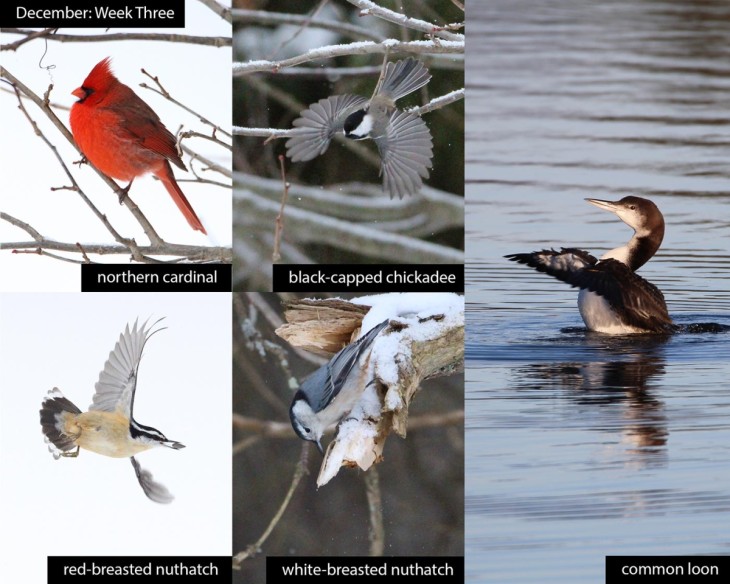This week in the woods, we’ve observed a number of resident birds, as well as a loon that we hope has moved on to open coastal waters.
Northern cardinals were uncommon in the Upper Valley as recently as the 1980s, but their range has expanded. Highly territorial in summer, male cardinals especially will get into conflicts with each other, birds of other species, and even their own reflections. However, in winter, they grow more peaceable and sometimes join mixed-species flocks.
Black-capped chickadees often form the nucleus of such winter flocks. They often find newly hung feeders before other birds do, and winter migrants and fellow year-round residents alike follow chickadees’ vocalizations to the best foraging opportunities. In The Genius of Birds, Jennifer Ackerman writes that scientists have deemed chickadee calls “one of the most sophisticated and exacting systems of communication of any land animal” and almost akin to language. Comprehensible even to other species, the calls can convey the locations both of the caller and of food and warn of specific predatory threat types.
Relatively intelligent birds, chickadees have brains twice the size of birds of similar weight such as flycatchers and swallows – and chickadees living in the chilly Northeast may be especially smart. Researchers have found that northern chickadees have larger hippocampi, with more neurons, than do their counterparts living in the warmer parts of their range. The likely reason for this difference in the part of the brain dedicated to memory and spatial learning is that in harsh climates, chickadees rely more on cached food supplies; they stow thousands of seeds in bark, buds, needle fascicles, and other hideaways, and this strategy requires an excellent memory. Of course, brain power comes at a caloric cost, and chickadees don’t need capacious memories in summer, when they have the competing energy demand of raising chicks and feed more often on invertebrates. As an evolutionary solution for this seasonal shift in priorities is a brain that grows and shrinks over the course of the year. In autumn, after chicks have fledged, a chickadee’s hippocampus enlarges by approximately 30 percent.
Red-breasted nuthatches and their larger cousins, white-breasted nuthatches, are also showing up at feeders and, like the chickadees, will cache whatever they can’t immediately consume. They also raid other birds’ larders. Aided by long, dinosaur-ish hind toe claws, both nuthatch species can climb down trees headfirst, which allows them to spy tucked-away seeds (as well as winter invertebrates, including pupae and eggs).
Finally, we were concerned to find a common loon swimming on Post Pond in Lyme, New Hampshire, on Friday. The bird was diving and preening in about 40,000 square feet of open water. The sight reminded us of Brett Amy Thelen’s story in the winter issue of Northern Woodlands describing the work of conservation organizations to aid stranded loons. If loons remain too late on inland lakes, they may become stranded, both because encroaching ice may not give them enough of a runway to achieve liftoff (they typically require about 100 yards of open water) and because their annual “catastrophic” molt leaves them flightless. Once stranded they risk starvation, becoming trapped under the ice when they dive, and predation by bald eagles. When we checked the pond again on Saturday, ice had covered the lake, and we couldn’t see the loon. If you see a loon on a lake this winter with the ice closing in, note the location, take a photo or video, and share this information with one of the organizations listed in Thelen’s article.
What have you noticed in the woods this week? Submit a recent photo for possible inclusion in our monthly online Reader Photo Gallery.


